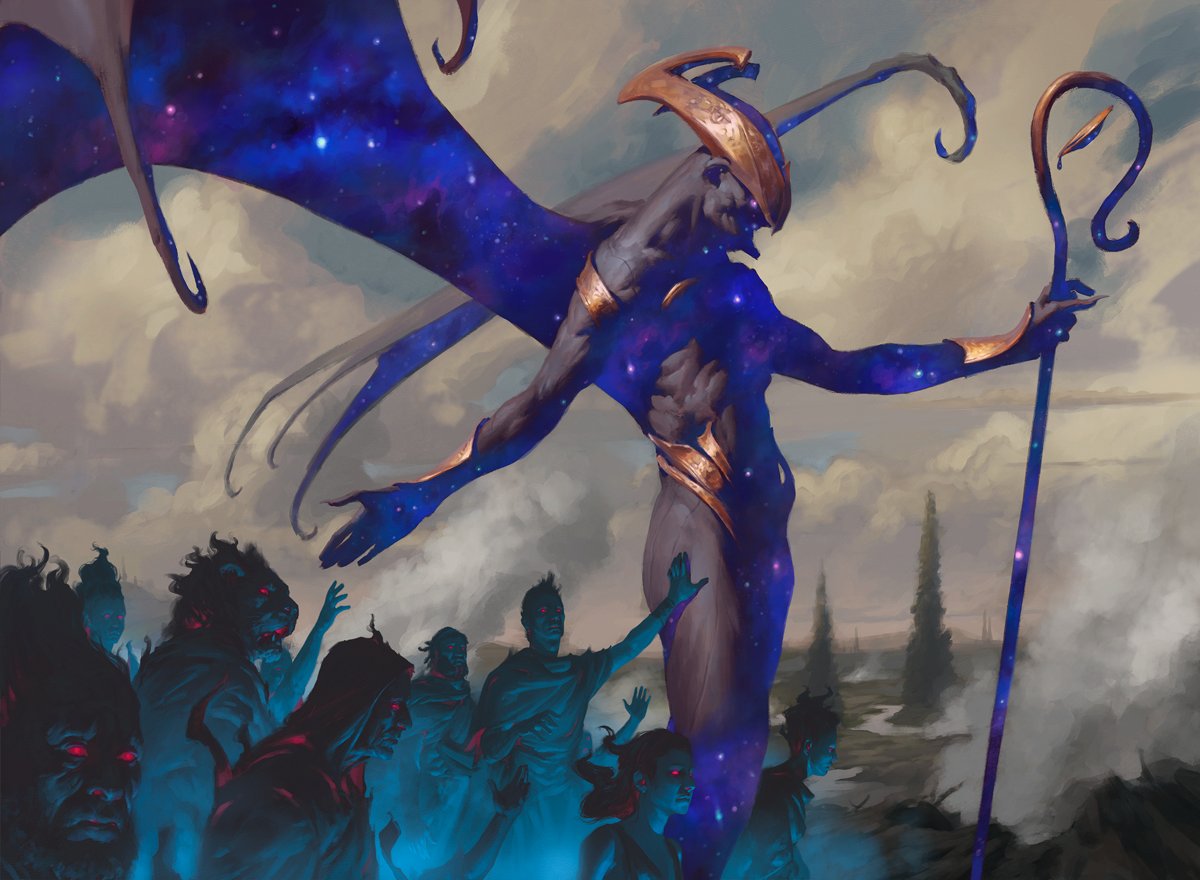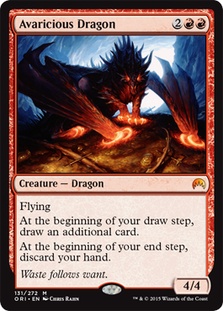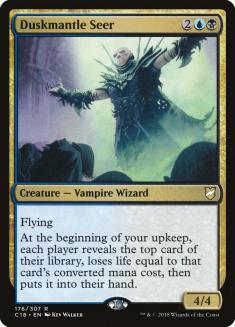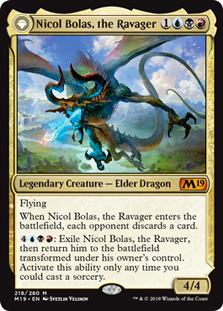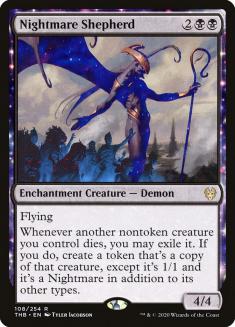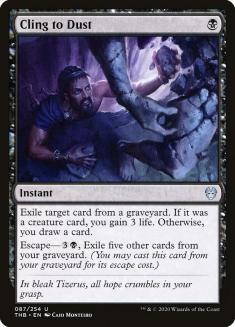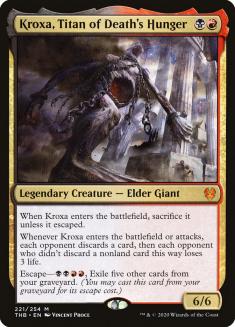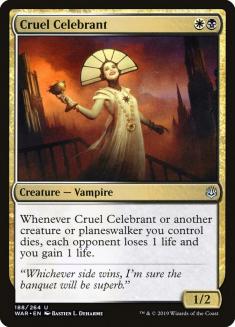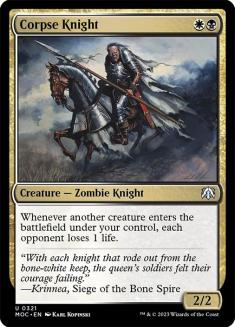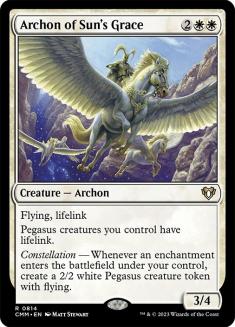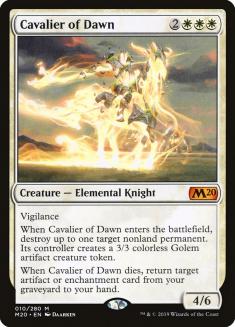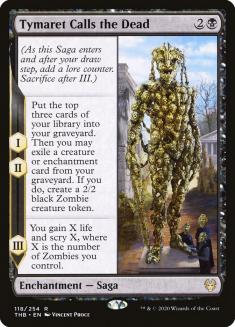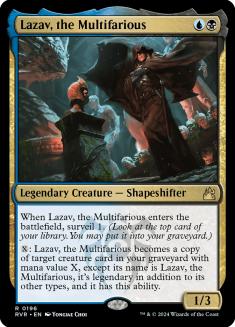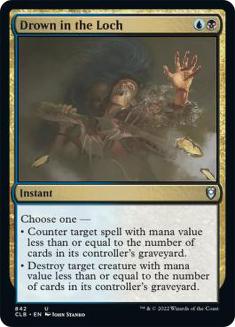4/4 flying for four mana. A decent but unspectacular return on rate. In fact, if you were look over the 32 4/4 four-mana flying creatures throughout Magic’s history, you’d see a pretty prolific group of cards that garnered way too much hype prior to their release.
These cards seemed like a bargain when they were previewed, but all fell far short of the expectations the hive mind had for them. There seems to be something amiss with our expectations for what the body of a 4/4 flyer is truly worth. As planeswalkers become the norm in Standard, the demands for return on mana investment continue to increase. Why invest four mana for a card that’s primarily leveraged through combat when a planeswalker of similar (or lesser) cost affects the game on every conceivable axis? The simple answer is you shouldn’t. Get ready to put your shades on and say it with me. We won’t get fooled again.
Oh no. Okay, hear me out. So many of these other 4/4 flyers needed an extended period on the battlefield to make a meaningful impact with their secondary functions. Nicol Bolas’s planeswalker transformation may have been game altering, but it was always accompanied with tremendous risk. A single discard from your opponent, a single card drawn in your upkeep…this doesn’t equal a won game. Nightmare Shepherd, if properly built around, will create scenarios where its ability will win the game on the spot.
Creatures (26)
- 4 Gray Merchant of Asphodel
- 3 Yarok's Fenlurker
- 4 Knight of the Ebon Legion
- 3 Murderous Rider
- 3 Ayara, First of Locthwain
- 4 Cauldron Familiar
- 1 Deathless Knight
- 4 Nightmare Shepherd
Lands (25)
Spells (9)

My Mono-Black Devotion decks continue to lean on the Cat Oven combo, and as such can generate a Nightmare copy at a moment’s notice. In spots where a Gray Merchant of Asphodel has already been cast, a Nightmare Shepherd plus sacrifice outlet will almost always close out a game. And while Gray Merchant is the obvious creature to return to the battlefield, copies of Yarok’s Fenlurker plus a sacrifice outlet will provide you access to the rarely seen instant-speed discard effect. Knight of the Ebon Legion suffers minimal downgrades when returned to the battlefield with Nightmare Shepherd. And who cares what Ayara’s power and toughness are? Once Nightmare Shepherd is on the battlefield, it demands an answer.
To account for this fact, we’re leveraging a manabase loaded with card advantage and selection. There’s a chance that you’re supposed to be playing some black Temples over Witch’s Cottage, but when your threats are as game-breaking as Gray Merchant and Nightmare Shepherd, it’s easy to make a case that you want to be casting them multiple times. I also am positive you want four copies of Castle Locthwain, and additional Swamps instead of Temples will help eliminate some awkward draws.
Cling to Dust is a card heavily featured in most of my lists today, so it shouldn’t surprise you that I believe it is one of the most impactful cards in the set. Escape feels extremely undervalued to me right now. Having a potential instant-speed answer to a graveyard threat that can just sit in your graveyard forces your opponent to respect open mana, and in long games another repeatable source of card advantage is always welcome. The more ways you can deposit this card in the graveyard directly, the more you must consider it for all your black decks. The opportunity cost is so low, and the potential impact so high — classic hallmarks of a sleeper card.
I think there are many ways to build a Mono-Black Devotion list right now, and, while I do think Nightmare Shepherd will prove to be the strongest four-drop, you can make strong cases for several cards to occupy its slot. Shepherd really starts to shine when your deck is focused on it, as in the following Rakdos list.
Creatures (25)
- 2 Plaguecrafter
- 3 Cavalier of Night
- 4 Yarok's Fenlurker
- 4 Knight of the Ebon Legion
- 3 Woe Strider
- 1 Erebos, Bleak-Hearted
- 4 Kroxa, Titan of Death's Hunger
- 4 Nightmare Shepherd
Lands (27)
Spells (8)

Resource denial is a gameplan that continues to tantalize me. In theory, snowballing cards like Nissa, Who Shakes the World; Hydroid Krasis; and Uro, Titan of Nature’s Wrath should be able to punch through efforts to attack a hand directly, but there are just so many powerful ways to strip cards from your opponents. We’ve got our own titan in Kroxa, Titan of Death’s Hunger and while Uro continues to get all the press, I expect Kroxa to be every bit as prevalent. Uro will benefit early from being slotted in very refined shells and Kroxa doesn’t have the same head start. Despite this, it wouldn’t shock me to see these cards regarded as equally powerful when their time in Standard is said and done.
It may seem like Kroxa and Nightmare Shepherd have negative synergy at first glance, but I would disagree. Due to Kroxa’s escape ability, redundant copies are mostly disposable, and turning drawn copies into two discards and six potential damage for just two mana is a tremendous swing. Let’s not even talk about a three-cast scenario. We again have access to instant-speed discard in this deck, but instead of Witch’s Oven, we’ve got Woe Strider to thank. I think this card is playable on its face with zero sacrifice synergies. Again, people are underrating escape. When it is enabling abuse of enters-the-battlefield triggers alongside Nightmare Shepherd, there’s zero question that it’s a slam dunk. I think we can push this aspect of our deck even harder if we want.
Creatures (28)
- 4 Midnight Reaper
- 4 Cruel Celebrant
- 3 Cavalier of Night
- 4 Corpse Knight
- 2 Murderous Rider
- 4 Cauldron Familiar
- 3 Woe Strider
- 4 Nightmare Shepherd
Planeswalkers (2)
Lands (25)
Spells (5)

The Cruel Celebrant / Corpse Knight team-up always seemed like it was a free sacrifice outlet away from being a very real thing. Enter Woe Strider. With Nightmare Shepherd on the battlefield, this deck can kill an opponent from an absurd life total. You also benefit from the fact that all your creatures have zero interest in sizing.
Elspeth, Sun’s Nemesis is a return to pre-War of the Spark planeswalkers. You must build around her, but if you do, she can provide massive returns. I wouldn’t be surprised if this deck ends up playing more copies in the future. After all, Corpse Knight and Cruel Celebrant do their thing just as effectively with tokens.
It’s hard for me to envision losing a game when I cast Cavalier of Night on a battlefield that contains a Nightmare Shepherd and a sacrifice outlet. This deck is equal parts grindy and explosive, and sure to be a blast to play. It’s just a question how long folks will allow graveyard shenanigans to go uncontested. My guess? Not long.
Hey, did you know Nightmare Shepherd is an enchantment?
Creatures (25)
- 4 Starfield Mystic
- 4 Cavalier of Dawn
- 4 Aphemia, the Cacophony
- 3 Archon of Sun's Grace
- 4 Eidolon of Obstruction
- 2 Alseid of Life's Bounty
- 4 Nightmare Shepherd
Lands (25)
Spells (10)
Sideboard

I would say this is more proof of concept than actual deck, but there’s some potential here. Archon of Sun’s Grace is a legitimate reason to explore a deck comprised of 50% enchantments. This card is unraceable and evasive — a scary combination.
There’s never been a truly devoted Cavalier of Dawn deck, and I get it. It’s surely the least impressive member of the cycle. But when you consider what this card does with a Nightmare Shepherd on the battlefield and its ability to interact favorably with opposing planeswalkers, you can start to get on board. It’s hard not to just shove Cat Oven in every single deck but I do want to at least check if we can hard commit to the enchantment ideal. The more likely final configuration probably gives up on Starfield Mystic and buys into the recursive combo. The Core Set 2020 plant has the potential to be worth two to three mana per turn, though. The issue in building our deck like this is how clunky it will feel without Starfield Mystic.
I do not yet buy Tymaret Calls the Dead as a Constructed-quality card. It does seem like we need to do something to juice our graveyard if Aphemia, the Cacophony is going to earn a slot. And besides, you can bear some underpowered options if the synergies are worth it.
Creatures (13)
- 2 Lazav, the Multifarious
- 2 Murderous Rider
- 2 Woe Strider
- 1 Atris, Oracle of Half-Truths
- 4 Kroxa, Titan of Death's Hunger
- 2 Nightmare Shepherd
Planeswalkers (5)
Lands (27)
Spells (15)
Sideboard

I leave you with one final tease, and I almost regret doing this to you folks. I know many of you are powerless to resist the allure of a Nicol Bolas, Dragon-God and you can count me among that number. The creature count here feels a bit low to commit to Nightmare Shepherd, but the few cards you stand to get back are so incredible, and no deck does a better job of resource denial than a Bolas-based Grixis deck. Add Ashiok’s minus into the mix, and you might just put together a planeswalker that can permanently answer any permanent.
With Lazav and Thought Erasure, we finally can just throw a Kroxa in our graveyard via surveil. I can’t imagine a better feeling. We also have the exceedingly nasty Lazav/Kroxa combo at our disposal. Maybe more Lazavs are justified?
One of the upsides of playing a ton of discard effects is that Drown in the Loch will turn on much earlier than it has up until this point. There’s no question the card has Standard potential, but you do have to work to turn it on if you want a quality card.
On top of the synergies mentioned, every single deck here can benefit from the chip damage and closing speed a 4/4 flying Nightmare Shepherd can provide. While the body size may not be the reason we came, it is sure to be the reason Nightmare Shepherd will torment the dreams of Standard players for the foreseeable future. Don’t sleep on this card!

